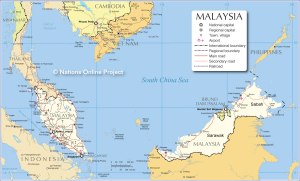For general information about the country profiles click here.

Population: 29,239,927
HDI ranking: 64/187
HDI score: 0.769
Malaysia currently has no elected local government. A traditional top-down approach to local administration constrains the capacity of local government and leads to a gap between “demand” and “supply” in its service delivery. However, growing community awareness is challenging the practice of centralized administration (Phang, 2008).
Local governance at a glance
- Malaysia is divided into 13 states (which are subdivided into districts) and three federal territories. The states are administered by the federal and state governments, while the federal territories are directly administered by the federal government (MyGovernment, 2014).
- There are three tiers of government (federal, state, and local), and three types of local authorities (city, municipal, and district councils) that are responsible for providing basic infrastructure and public utilities. Municipalities and cities are also responsible for urban planning, public health and waste management, and city councils additionally engage in revenue collection and law enforcement (CLGF, 2013).
- The Ministry of Housing and Local Government (MHLG) executes and monitors “all laws pertaining to local government.” In addition, the Ministry of Federal Territories and Urban Well-Being oversees local authorities in the federal territories of Kuala Lumpur, Putrajaya and Labuan (CLGF, 2013).
- The National Council for Local Government (NCLG) was formed in 1960 to “ensure uniformity of local government laws and policies” in the country. The Constitution provides for the NCLG to formulate policies and oversee the administration of local government laws (CJLG, 2013).
- Local elections in every state have been suspended indefinitely since 1965 under Section 15 of the Local Government Act 1976. The state government appoints councilors for 3-year terms in the local councils (CLGF, 2013).
- There are no legislated gender quotas at the local level (Chen, 2010).
Civil society actors
- Aliran Kesedaran Negara is Malaysia’s oldest human rights group that advances social justice, democratic reforms, including transparency and accountability in governance, and citizen participation (Aliran, 2014).
- SUARAM is a human rights organization that promotes civil and political rights including freedom of expression, peaceful assembly, political accountability and democracy-building (SUARAM, 2014).
Capacity building institutions
- The National Institute of Public Administration (INTAN) provides training to public servants on topics including financial, land and local government administration (INTAN, 2014).
Fiscal control
- Income for local authorities comes mainly from taxes, non-tax revenues and allocations from federal as well as state governments (UCLG, 2006).
- Tax revenue from “self-assessed income tax” accounts for 60-70% of local authorities’ revenue (CLGF, 2013).
- Launching grants provided by the state to local authorities need to be approved by MHLG. The amount of grants to a particular council depends on factors such as land area, population size, and expected revenue. The state governments have “direct financial authority” over local governments (UCLG, 2006).
- “Local government accounts for 1% of the GDP” (Phang, 2008).
Key initiatives for participatory local governance
- Local Government Act 171 (1976) stipulated the appointment of councilors to local government from amongst members of the public. Act 172 stipulated local government’s duty of taking into account representations and objections from the public (UCLG, 2006).
- In 1998, MHLG supported a national program to implement Local Agenda 21, a partnership program to expand community participation in the work of local government (Phang, 2008).
- In 2007, the central government started an electronic system, e-PBTs, to bring local government closer to citizens. The four elements of the system are accounts, taxation, e-submission, and complaints (CLGF, 2013).
Challenges for participatory local governance
- Autonomy and capacity of local government are constrained by the delegation of additional burdensome services from the central government such as addressing a rise in the urban crime rate, severely taxing local government’s financial and human resources (Phang, 2008).
- The central government still tightly controls local governments which have limited revenue and only a minor role. The lack of decentralization strains autonomy and public participation at the local level (Phang, 2008).
______________________
List of sources:
Commonwealth Local Government Forum (CLGF), 2013: “Country profile: Malaysia.”
Chen, L., 2010, European Journal of Comparative Economic Studies: “Do Gender Quotas Influence Women’s Representation and Policies?”
MyGovernment: The Government of Malaysia’s Official Portal, 2014: “Subdivisions.”
National Institute of Public Administration, 2014: http://www.intanbk.intan.my/i-portal/.
Persatuan Aliran Kesedaran Negara, 2014: http://aliran.com/.
Phang, S., 2008, Commonwealth Journal of Local Government: “Decentralization or Recentralization? Trends in local government in Malaysia.”
Suara Rakyat Malaysia (SUARAM), 2014: http://www.suaram.net/.
United Cities and Local Governments (UCLG), 2006: “Malaysia.”
